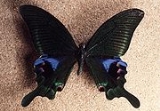
Papilio arcturus
Encyclopedia
The Blue Peacock is species of swallowtail
butterfly found in India
.
Male has the upper wings brownish black, somewhat paler on the fore than on the hind wing. Fore wing irrorated with brilliant golden-green scales that on the posterior half of the wing form a broad, not well-defined subterminal band; the veins and elongate streaks between them on the outer half of the wing velvety black. Hindwing has the posterior three-fourths irrorated with brilliant golden-green scales as on the fore wing but towards the base anteriorly these are blue; a conspicuous brilliant blue patch somewhat irregular in shape occupies the apex of the cell and the bases of interspaces 5 and 6, prolonged as a broad streak in the latter interspace up to the terminal margin; below this a more or less triangular patch on the disc and above it the whole of the costal margin broadly are devoid of the irroration of green scales; a subterminal generally incomplete series of large claret-red lunules terminates at the tornal angle in a large conspicuous black-centered red ocellus; the latter is encircled above and anteriorly by a narrow band formed by a conflux of the green irrorated scales ; the lunules are bordered outwardly by spots of the ground-colour that are devoid of the green scales; finally both the lunules and the tornal ocellus are tinged more or less with bluish-purple on their inner margins, underside dull black, with a somewhat sparse irroration of yellowish-white scales confined on the fore wing to the base and apex, and on the hind wing to the posterior two-thirds, not extended to the termen except along the tail. Fore wing: a broad ill-defined subterminal pale transverse area, crossed by the black veins and internervular streaks, and elongated pale cellular streaks. Hind wing: a large somewhat quadrate terminal black-centred claret-red patch in interspaces 1 and 2, and a subterminal series of broad claret-red lunules that extends from interspaces 3 to 7, followed by ill-defined anticiliary red spots in each interspace. Cilia of both fore and hind wings white, alternated with black. Antennae, head, thorax and abdomen brownish black; the head, thorax and abdomen at base on the upperside sprinkled with golden-green scales.
The female is similar to the male but the markings are more prominent. Upperside of fore wing has the subterminal golden-green band broader and on the hind wing the subterminal series of claret-red lunules more complete than in the male.
Swallowtail butterfly
Swallowtail butterflies are large, colorful butterflies that form the family Papilionidae. There are over 550 species, and though the majority are tropical, members of the family are found on all continents except Antarctica...
butterfly found in India
India
India , officially the Republic of India , is a country in South Asia. It is the seventh-largest country by geographical area, the second-most populous country with over 1.2 billion people, and the most populous democracy in the world...
.
Description
- See glossaryGlossary of Lepidopteran termsThis glossary describes the terms used in the formal descriptions of insect species, jargon used mostly by professionals or entomologist....
for terms used
Male has the upper wings brownish black, somewhat paler on the fore than on the hind wing. Fore wing irrorated with brilliant golden-green scales that on the posterior half of the wing form a broad, not well-defined subterminal band; the veins and elongate streaks between them on the outer half of the wing velvety black. Hindwing has the posterior three-fourths irrorated with brilliant golden-green scales as on the fore wing but towards the base anteriorly these are blue; a conspicuous brilliant blue patch somewhat irregular in shape occupies the apex of the cell and the bases of interspaces 5 and 6, prolonged as a broad streak in the latter interspace up to the terminal margin; below this a more or less triangular patch on the disc and above it the whole of the costal margin broadly are devoid of the irroration of green scales; a subterminal generally incomplete series of large claret-red lunules terminates at the tornal angle in a large conspicuous black-centered red ocellus; the latter is encircled above and anteriorly by a narrow band formed by a conflux of the green irrorated scales ; the lunules are bordered outwardly by spots of the ground-colour that are devoid of the green scales; finally both the lunules and the tornal ocellus are tinged more or less with bluish-purple on their inner margins, underside dull black, with a somewhat sparse irroration of yellowish-white scales confined on the fore wing to the base and apex, and on the hind wing to the posterior two-thirds, not extended to the termen except along the tail. Fore wing: a broad ill-defined subterminal pale transverse area, crossed by the black veins and internervular streaks, and elongated pale cellular streaks. Hind wing: a large somewhat quadrate terminal black-centred claret-red patch in interspaces 1 and 2, and a subterminal series of broad claret-red lunules that extends from interspaces 3 to 7, followed by ill-defined anticiliary red spots in each interspace. Cilia of both fore and hind wings white, alternated with black. Antennae, head, thorax and abdomen brownish black; the head, thorax and abdomen at base on the upperside sprinkled with golden-green scales.
The female is similar to the male but the markings are more prominent. Upperside of fore wing has the subterminal golden-green band broader and on the hind wing the subterminal series of claret-red lunules more complete than in the male.

